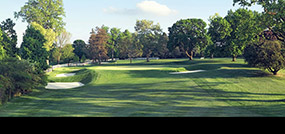Founded in 1898, the Baltimore Country Club was established on a 150-acre property in Roland Park, a few miles north of Baltimore city. The club’s original course hosted the 1899 US Open but as the membership grew and the game’s popularity increased, the need for an expanded facility became apparent. In the 1920s architect A.W. Tillinghast was hired to help the club identify an appropriate site upon which to add a second course, his chosen site comprising of five farms in the village of Timonium, a few miles farther to the north. After the land was acquired, Tillinghast designed what became known as the East Course, which opened for play in 1926.
Tillinghast selected the Five Farms property because of the natural shape of the rolling terrain and the fact that he could build many of his fairways and greens without moving much earth. He also had space and some irregular ground undulations, so unlike his more famous works at Winged Foot and Baltusrol, here the golf is a lot less back and forth as holes regularly change direction and bend to all points of the compass. A key feature of the design are the green complexes, which generally lean steeply from back-to-front and are often elevated with their putting surfaces obscured from the fairway.
Despite its pleasant parkland surrounds, this is a stiff test of golf with wayward driving, sloppy iron play and imprecise putting all carrying heavy penalties. The severity of the challenge is evident immediately, the round opening with two of its strongest par fours. The 1st tracks up a slight rise and the 2nd falls back the other way, with both featuring large, sharply pitched targets that will torment those above the hole and reject anyone coming in too lightly on their approach. Other par fours likely to cause concern include the long uphill 5th and the dogleg left, dogleg right double act at the 7th and 8th. The 10th, which follows a small creek and heads toward a green pressed against a pond, is another fine two-shotter as is the 15th with its wonderful side-hill approach played from one attractive ridge to a target perched atop another.
The par threes are also very good, particularly the short pushed-up 4th and the longer 17th, its green benched into a hillside and set immediately beyond a nasty gully. Your biggest threat to par, however, may actually come from Tillinghast’s two distinctive par fives. First is the 6th, a reverse Road hole that bends left around an old farm barn, its small green only reachable in two for those who can shorten the hole by carrying the out-of-bounds building with their drive. The other memorable par five is the 14th, which is cut by a gnarly cross-hazard comprised of sand, mounds and thick rough. The hole drops substantially beyond the hazard and then rises from the bottom of a deep basin into an elevated target circled by sand.
Although the East Course at Baltimore County Club has been lengthened to retain its championship pedigree, the holes have remained remarkably well preserved over the years with the club reluctant to tamper with Tillinghast’s precious gift. It may not boast quite the number of world-class holes of other Golden Age gems along the Eastern Seaboard, but this is one of Tilly’s finest creations and is a course that all golfers are bound to enjoy.

 this course also has exceptional:
this course also has exceptional:
